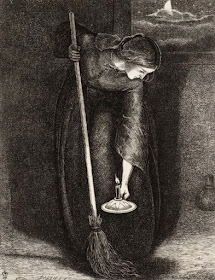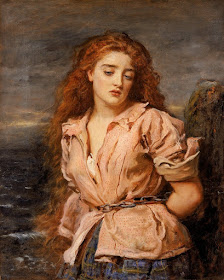It was at the Royal Academy that he met William Holman Hunt and Dante Gabriel Rossetti, both two years older than he was. The three of them were disappointed by the teaching at the academy, which they thought was overly stylized and formal. They wanted to paint in a way that felt more real and emotional, infused with "true spirit." Somehow they got the idea that painting had changed drastically in the high Renaissance, from a focus on God or the world to a focus on the artist himself. It was Michelangelo and Raphael, they thought, who led this change. So they formed the Pre-Raphaelite Brotherhood to take painting back to medieval authenticity. For a while they signed all their works with PRB rather then their names. This is one of the first works with that signature, Millais' Lorenzo and Isabella, 1849. The story comes from Boccaccio's Decameron; Isabella, from a wealthy merchant family, falls in love with one of their servants, Lorenzo, but her brothers find out and cut off his head. She takes the head and puts it in a pot of basil, which she then keeps with her always.
Most of the early works of the Pre-Raphaelites are, to put it bluntly, weird; they may have escaped from Renaissance egoism but at the price of creating very strange art. This is Autumn Leaves, 1855. Fortunately, they soon got over it.
Ophelia, 1852, Millais' most famous work by far. This might also be the most famous Pre-Raphaelite painting, but it doesn't look much like the rest of them. Or perhaps the stiff anti-naturalism looks better on a corpse. Detail at the top.
The Lost Piece of Silver, illustration for a book of the parables of Jesus published in 1864. Millais also did illustrations for books by Trollope and Tennyson.
The Knight Errant, 1870. By this point the distinctive colors and oddly crisp lines of the Pre-Raphaelite Brotherhood have been left far behind.
The Martyr of the Solway, 1871. The martyr was Margaret MacLachlan, an 18-year-old Scottish covenanter from Wigtown who was executed in 1685 for refusing to acknowledge that the king was the head of the church. X-ray studies recently showed that the martyr was originally naked. It seems that Millais got a lot of grief for such a sexualized portrayal of a Protestant martyr, so he caved to bourgeois opinion and gave her clothes.
Millais painted more than a hundred landscapes, many of which are still in private collections. Above are two Scottish scenes, Chill October, 1870, and Murthy Moss, 1887.
The Sound of Many Waters, 1876.
Effie in 1873.
Self portrait of 1880.
Beginning around 1880 Millais began to collect fat commissions for portraits of wealthy or important people. John Ruskin considered such works to be "inauthentic" – the 19th-century equivalent of selling out – and he turned against Millais and broke off their friendship in a dramatic scene. After all, what is stealing a spouse compared to producing inauthentic art? Not having such firm opinions myself, I think some of Millais' portraits are grand. This is John Cardinal Newman, 1881.
The young rebel Millais ended up being made a baronet and then president of the Royal Society. He is buried in the Artists' Corner of St Paul’s Cathedral between Frederic Leighton and JMW Turner, two of the artists he attacked in his Pre-Raphaelite days. Such is the career of the modern artiste. Dew-Drenched Furze, 1890.

















No comments:
Post a Comment